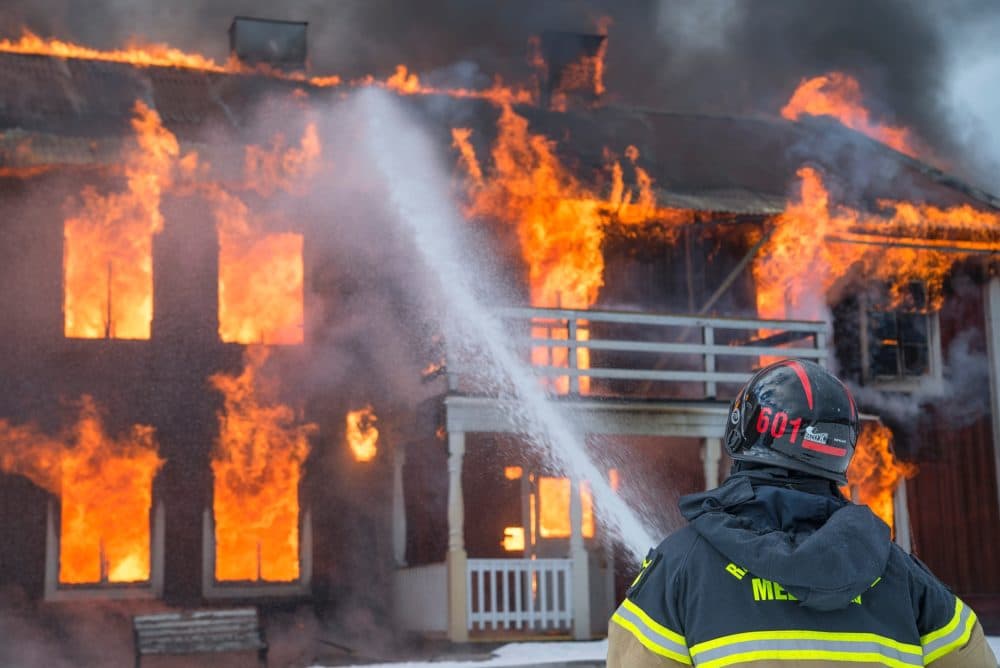Advertisement
Commentary
Firefighters Put Their Lives On The Line In Fires — And At Firehouses

Picture a firefighter. They’re probably coming out of a blazing building surrounded by flames and smoke, covered in soot. Firefighters have dangerous jobs, but an important health risk may also wait for them at the firehouse.
This iconic image of a firefighter in front of a burning building is reflected in where we spend our research efforts: how fires impact health, not where firefighters actually spend most of their time — the firehouse.
Firefighter cancer statistics are startling. In Boston, almost 200 firefighters have died from cancer since 1990 and nearly every three weeks another one is diagnosed. Research indicates that firefighters have elevated rates of certain cancers (mostly digestive, oral, respiratory, and urinary) when compared to their civilian counterparts.
In July, Massachusetts Gov. Charlie Baker signed legislation that formally acknowledges cancer as a work-related injury for firefighters. This will help firefighters across the Commonwealth access critical health care benefits while undergoing cancer treatment. While this is an extremely important law that provides support for firefighters with cancer diagnoses, it does not get at the root of the problem.
Despite strikingly high firefighter cancer rates, finding the underlying culprit has proved elusive. The specific cancer risks often vary by study, suggesting there may be factors other than direct firefighting exposures at play. The firehouse might provide clues. After all, these are firefighters’ second homes — where they sleep, eat, exercise and work, often in 24-hour shifts. They could be exposed to carcinogenic pollutants such as diesel exhaust from trucks and contaminants attached to gear brought back from fires.
I began researching firehouse exposures in 2015, when the Boston Fire Department and Local 718 Union approached my research group for help with cancer prevention. This request struck close to home, because only one year prior, my apartment building caught on fire and I witnessed the brave efforts of firefighters firsthand. I’ll never forget the panic and fear of watching my home go up in flames, but it was what was left behind — the smell of smoke that lingered for weeks after the fire was extinguished — that really struck me. It made me wonder: What chemicals were contained in the soot? And what were firefighters bringing back to firehouses?
In our initial study, “Firehouses for Health,” we found out just how important the firehouse is to firefighter health. In a newer station, contaminants from the truck bay, such as diesel exhaust, were contained and did not migrate into the living quarters, where firefighters spent most of their time. However, in other stations we detected contaminants in living quarters that were likely generated from diesel exhaust and other bay sources. At these stations, contaminated air could move freely into the living quarters, likely due to open doors and fire pole holes, which act as direct conduits for air to move between floors.
Advertisement
We need to include the firehouse in a holistic approach to reduce cancer rates.
The overall proportion of cancer attributed to firehouse carcinogens may be relatively small compared to carcinogens from fires. But the problem is, we just don’t know. The science on firefighter cancer suggests that there is no single cause. We need to include the firehouse in a holistic approach to reduce cancer rates. We need to acknowledge that firehouse exposures to carcinogens are part of the firefighter cancer story, and we need to focus on strategies to minimize the likelihood of such exposures.
There are some things that can and should be done immediately: First, reduce exposure from contaminants released into the air from fire-exposed gear, and next, limit how air moves between the bay and living quarters.
For decades, most fire departments did not have equipment in-house to clean gear. Nobody generally complained since firefighters often looked at fire-related grime as a badge of honor. We now know better. Departments should require that firefighters clean gear and equipment regularly and keep fire-exposed gear out of living spaces. Recently, some departments have purchased the equipment to clean gear in-house, but many still do not. This needs to change.
There are also low-cost improvements that make firefighter living quarters a safer environment. Keeping outside-facing windows and bay doors open longer can increase natural ventilation. Ensuring that doors between the bay and living spaces remain closed can reduce air transfer between quarters.
We also need more research on the full impact of firehouse carcinogen exposures and more preventative measures at firehouses. Firefighters protect us when we face crises in our homes. The risks are great and visible during fires and firefighters take precautions to match the hazard — donning helmets, masks, boots and jackets. But what if another major hazard starts when they get back to their "house," when they take off all their protective gear?
